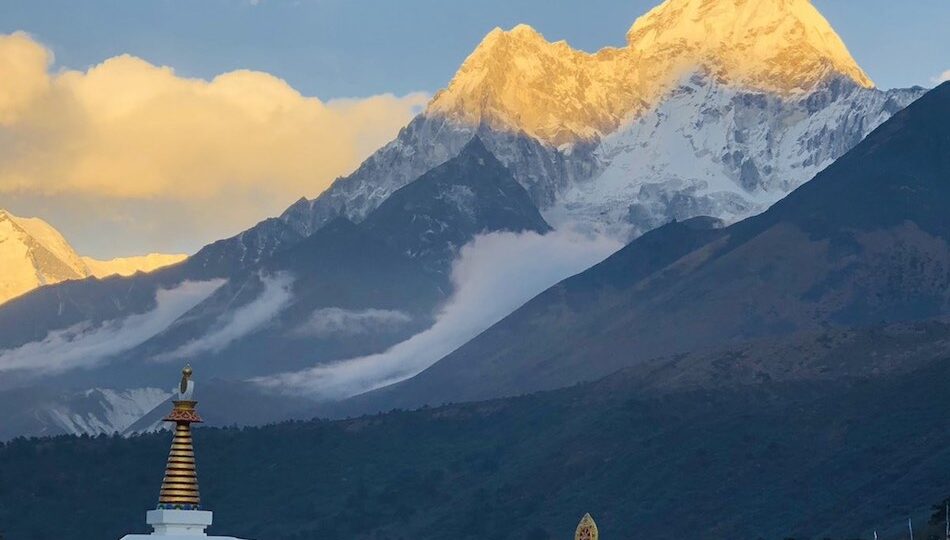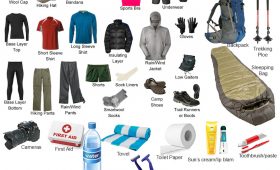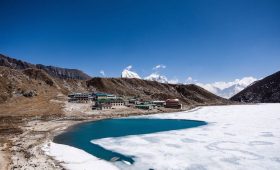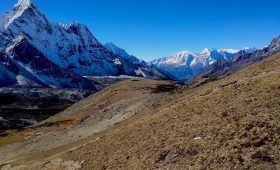In January, winter arrives in Nepal and Everest Base Camp as well. In the snow-covered routes of the Everest region, an Everest Base Camp trek in January can be a unique adventure.
This is the coldest month in the Everest region, thus there are less tourists on the trekking routes. During this time, you will experience the most peaceful treks with unspoiled views.
Although there will be many cold temperatures with wind chills, trekking to Everest Base Camp is doable with right gear and physical preparation.
Everest Base Camp Trek Highlights
- An exciting mountain flight to and from Lukla airport
- A spectacular view of snow-covered Everest and other Himalayan giants
- The full attention and hospitality of local tea house owners and villages Panoramas of the snow-covered mountains
- Absolutely beautiful sunrise or sunset view at Kala Patthar- 5,643 m
- An enjoyable and thrilling trekking experience.
- Less crowded and joyful trekking experience.
Everest Base Camp Trek in January Weather
In Nepal, January is the middle of winter. As a result, it’s one of the coldest months of the year.
Temperatures in the Everest Region fall below freezing at night. But, the days are quite sunny, beautiful and cloudless. Snow begins to fall in the Everest Region in mid-December.
Temperature during this January trek, the days are comfortable, but the nights and early mornings are cold.
The typical daytime temperature in the Everest region is between 8 to 12 degrees Celsius. During the night, the average temperature lowers to -16 degrees. Even if it snows, you can begin your journey as soon as it stops.
Gorakshep (5180 m) is the highest overnight destination on your Everest Base Camp trek. The average daily temperature in this area is roughly -10°C. The nights and mornings are cold, with average temperatures around -19°C. The days are warmer, with temperature ranging -2°C.
Average Daily Sunshine
In January, the sun shines for an average of 5-7 hours every day in the Everest Region.
You can enjoy your treks in a warm and comfortable environment during these hours. After sunrise, the day temperatures rise up.
Wind
In January, the average daily wind speed is 8-12 mph. This is very windy.
It should be noted that the weather in the mountains is very unpredictable. This is true for a cold months like January. You may have to face various weather conditions in a single day. This includes unexpected weather changes such as blizzards and wind chill. Prepare to face any of these challenges.
Pros of Everest Base Camp Trek in January
Less Crowds
January is one of the ideal times for crowd-free trekking. In January, there are very few trekkers on the spectacular routes. As a result, you can enjoy the quiet and peace of the trails in January.
Amazing Views
You get some of the most wonderful views of the snowy mountain peaks in January. You can enjoy panoramic views of the surrounding landscapes and Himalayas. From the tops of ridges on the Everest Base Camp trek, you can see views of flat meadows. You can also gaze at the breathtaking snow peaks.
This is especially true for places such as Kala Patthar, the Khumbu Glacier, and Namche Bazaar. These places offer some of the best views in the world during January.
It is also the greatest time to photograph the scenery and mountains. Not only the views breathtaking and beautiful, but there are also pretty low chances of being photobombed by other hikers.
Choice of Flights and Accommodation
Unlike the peak season, January is not crowded with hikers and visitors. As a result, you’ll have plenty of choices for flights to and from Lukla. There is very little chance of missing the flights.
It is the same for lodging. In January, many guesthouses and lodges will want you to stay with them. As a result, you will get the guesthouse or lodge operators’ full attention and superb hospitality.
Snowfall and Skating
In the Everest Region, it is the mid-winter in January. As a result, there is a possibility of snowfall. You can enjoy the beautiful snow sprinkles. You can also choose to skate among the world’s highest mountains. It will create a wonderful story and memory.
Exotic Himalayan Trekking Experience
Unlike the busiest seasons, January offers a unique trekking experience. You may enjoy in the full majesty of the snowy mountain peaks and scenery. The winter trekking adventure has its own special magic. The perfect winter world of the Everest Region, with its magnificent and clear white snowy mountain peaks, is incredible.
Discounts and Free Services
January is the off-season for Nepal trekking. As a result, you can get better and cheaper discounts on flights and lodging during your Everest Base Camp trek. Instead of discounts, certain lodges and hotels provide complimentary services.
Cons of Everest Base Camp Trek in January
Shorter Day
The winter days (January) are shorter. So, you will have to trek slightly earlier to arrive at your destination before it gets dark and cold. The trekking hours is also less. Hence, you have less time to relax.
Deep Snow Piles
You will come across places with deep snow piles at higher altitudes. Hence, you may have to trek through heavy snow sometime. The snow might also cover the trails. During these times, make sure to follow the advice of your guides. Otherwise, you risk getting lost on your way to your destination.
Wind chills and blizzards
This is one of the most difficult challenges you will face on your January trip to Everest Base Camp. The cold wind can bring bad weather, such as blizzards, to the Everest region. Keep up to date on these facts and weather forecasts to ensure a safe trip.
What Should You Bring on Your EBC Trek in January?
For a safe and comfortable Everest Base Camp trek in January, proper preparation is required. Along with all of the regular essentials of a high altitude trek, you must also bring your winter necessities.
Things to consider before you pack:
- Windproof down jackets, trousers to keep the snow and the cold away.
- Lip balms, sunscreen lotions, winter gloves and caps, and a pair of thick socks to go with full-sleeve shirts. This helps to protect your skin and body, which are not normally covered by your clothing.
- Capacious and comfortable backpack. You will bring additional clothing in the cold. Clothing will also take up space. So As a result, you’ll need a strong, durable, and strong bag with enough space to accommodate all of your essential belongings.
- A durable, waterproof pair of hiking boots. A snow resistant boots that are crampon friendly will be helpful.
- Sleeping bag with liners: Make sure it is rated for -40 degrees Celsius. The guesthouses along the trails do not have heating system. These will keep you warm on those cold nights.
- Trekking Poles: Lightweight, adjustable poles that are easy to store, strong, and user-friendly. These poles are useful for uphill and downhill climbs and descents. They are ideal for support and balance, especially when walking in the snow.
Please keep in mind that these are only guidelines to help you pack for your EBC Trek in January. You are free to make changes to suit your needs.
Things to Consider during EBC Trek in January
Food
In winter, your body burns more calories than it would during warmer days. As a result, you should maintain your diet. Ensure that your diet is rich in carbohydrates and protein.
Do not let your stomach feel empty. Also, stay hydrated at all times. Water is a good healer.
Both of these help in avoiding altitude sickness. Avoid drinking alcohol before, during, and after the trek. This increases the effects of dehydration by making your body dry.
Sun Protection
Packing essentials for the EBC trek in January should include sun protection gear.
This includes sunscreen, a hat, lip balm with UV protection, and sunglasses.
The sun is scorching in the high altitudes during the daylight hours, because of the white snow in January, 80% of the sun reflects back to you. As a result, your skin burns more quickly.
Avoid Solo Trips.
Solo trips are a no-no during the winter. There are few to no other trekkers in the Everest region. Snow might also cover the trails. The chances of losing your route and not getting help are high. As a result, it is always recommended to travel with a guide or other trekkers.
Dress in Layers
Layering is essential for winter treks like this one. It will keep you warm. When you are cold or hot, it is easier to remove or add layers. When the weather changes, you won’t have to go through your luggage.
Begin Your Trek Early
In January, the days are shorter. So, you should begin your trek early in the morning. You’ll reach at the lodge before it gets dark and cold.
Travel Insurance
When trekking, always have travel insurance. Hiking is an outdoor activity and has its risks. To maintain the risk minimum and your mind at ease, having one is vital. Keep in mind your travel insurance covers travel to Nepal and altitude of 5000m.
Flexible Trek Itinerary
Allow some days for possible delays during winter treks in January. The w inter weather conditions are less predictable. It can lead to roadblocks, flight delays because of heavy snow on the trails or the region.
Hire a Porter
You’ll need to bring more than your usual high-altitude trekking gear. These will include your winter trekking gear as well as necessary equipment and supplies. You’ll also be trekking on snow. Due to the snow, the trails can be slippery and sloppy.
As a result, having a porter carry your bags will help lighten your load. It will also free you up to focus on your trip and the trails.
Proper Acclimatization Plan
Make sure you have a good and professional acclimatization plan. Always stick to it and do not skip it. You should spend at least two days acclimatization in Namche Bazaar and then in Dingboche. This will reduce the chance of high-altitude sickness.
Walk with Care and Mindfulness
Walking to EBC on the trails in January can be challenging. The trails may be covered with snow, making it slippery. So, stay focused on the trails and be careful while walking. This is especially the case after a heavy snowfall.
Following your guide and other experienced trekkers is the best way to ensure you’re walking on the safe side.
Preparation, both physical and mental
The EBC trek is a medium-length high altitude trek. In addition, January is a winter trip. As a result, doing some exercise, such as running or walking, and staying fit is essential. Make sure you get this training at least one to two months before your trip.
The more fit you are, the more pleasant the trek will be for you. Physical training will also help you mentally prepare for the trip. It will help you improve your overall performance.
Final Say
January is a peaceful and lovely trekking month for Everest Base Camp treks. It offers great adventure to the classic trip.
With some of the most gorgeous landscapes, January is the month to visit if you don’t mind the cold and are looking for adventure on the classic route.
Please contact us if you have any questions regarding Everest Base Camp treks in January. You can also contact us at any time of year for guidance and assist with this trek or any other treks in Nepal.
You May Also Like
- Everest Base Camp Trek in November
- Everest Base Camp Trek Packing List
- Everest Base Camp Trek Difficulty
Do you have any question about trip to Nepal?
Tell us about your trip to Nepal and what you expect from it. We will answer your questions in 24 hours and help you design a trip with a comfortable itinerary to best meet your needs.





